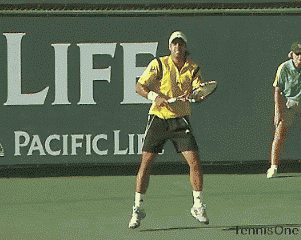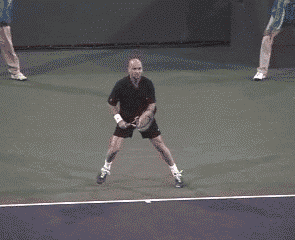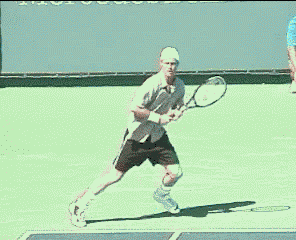|
TennisOne Lessons Strategy and Tactics of Tennis Ray Brown and Katherin Hashemi One of the most difficult problems a coach faces is the development of an orderly approach to strategy and tactics. The problem is, to have a comprehensive approach that can be adapted to any student, that strategies must be developed around the generic limitations of human performance rather than desired outcomes or simplistic weaknesses. In this way, one can teach strategy and tactics within a broader context that covers all situations and even suggests avenues to analyze to find weaknesses. One approach to tennis singles strategies is to conveniently organize them into six classes determined by the type of rally used. Each rally type is keyed to a specific generic human limitation in performance or training. While any particular rally or match may not fit into one of these six classes, these classes provide a very convenient organization of tennis strategies that can be used make sense of a very complex subject. Among other things, the importance of this organization is that it leads naturally to the construction of appropriate training programs. In turn, the development of training programs is supported by our articles on conditioning, power development, precision movement, technique and endurance. The Consistency Rally In this rally, the objective is to defeat your opponent with consistency. There is no use of power, change of ball dynamics, or ball direction. Hence this is the lowest risk strategy to implement. It only requires that you always hit the ball cross court and in the back nine consistently with moderate pace, regardless of what your opponent does.
A second possibility is the drop shot exit from the rally; the third possibility is a short ball due to an off-center hit. You must be alert to these changes in order to win the point by using this strategy. If you should consistently fail to win the point when the opponent bails out of the rally, your strategy will begin to work against you and your confidence will fade. As a result, to use this or any strategy effectively, you must have the ability to react to the typical changes that the strategy forces on your opponent. For example, if your opponent bails out by going down-the-line, you must be able to get to the ball and hit the cross-court shot or down-the-line shot to win the point; or, be able to stay in the point by hitting cross court and re-establishing the cross-court rally. Who May Use this as One of their Strategies? This strategy is found among lower ranked professional players but can be used at any level. Aniko Kapros and many female players have used this strategy at various times in their careers. At a higher level, Nadia Petrova and Fabrice Santoro often use this strategy. It is possible to reach a ranking of at least 300 on the WTA tour, using this as your only strategy. This approach can also obtain NCAA scholarships at many Division I colleges. At the high school level, players with this strategy can be found in any position. When all other strategies have failed, the consistency strategy can be used as a form of the persistence rally discussed below. Venus Williams has often resorted to this strategy in the third set of a very close match.
What to look for using this strategy: The point of the strategy is intimidation, hence we look for sings of intimidation. The most common sign is that the opponent will cease to move effectively. This arises from the natural effect of fear on the legs. It is not uncommon to see an intimidated player fail to adjust to a ball that is hit right at them. A second characteristic is for the player to be late is striking the ball. This results in unintentional down-the-line shots that can be mistaken for intentional. If you make this mistake, you can lose confidence in your strategy and abandon it prematurely. Miss hits are also a common sign when opponents are unable to cope with speed or get intimidated. You must be ready to react to these patterns, especially the down-the-line late hit. If you are not properly conditioned, you will tire out moving to these balls and hitting with power and will have to abandon the forcing rally. Who May Use this as One of their Strategies? Players such as Agassi may implement this strategy when playing much lower ranked opponents. Agassi's ball speed is often sufficient to win a match against a player who is unaccustomed to high speed rallies. Any top player with consistent high speed shots can also be seen using this rally against lower ranked players. Gonzales is an example of a player who can use speed to force errors without resorting to higher risk strategies.
Using the movement rally is higher risk and requires greater skill than either of the two previously described strategies. Also, it is higher risk than the persistence strategy described later in this article. In radar studies we have found that satellite and challenger players lose as much as 10mph of ball speed when forced to move. This often translates into a loss of depth, offering the opportunity to begin an attack. To execute this rally you must be in good enough condition to move and maintain your ball speed. Otherwise, you have compromised your own skill with this rally. Who May Use this as One of their Strategies? This was a standard approach of Agassi and so we often refer to this strategy as the A-Strategy. It was commonplace top see Agassi take up a position in the middle of the court and run his opponent back and forth until they bailed out of the rally with a desperation shot.
What to look for using this strategy: The most common features are visible exhaustion of the opponent with an increase in weak shots or unforced errors, especially first ball errors. It may only be necessary to engage in a single long rally to break a weaker opponent's will. If you are able to control the rally, it may be possible for you to stand near the mid point of the baseline and simply run your opponent from side to side until they drop. In using this strategy, one should resist the temptation to end the point. The longer the opponent is forced to run, the more quickly they will wilt and give you the match. Also, be aware that you do not have to move the opponent much to run them to death. The reason is that the energy losses of the opponent are mainly in stopping, hitting and reversing direction with precision. Any tactic that forces the opponent to continually reverse direction and sprint will quickly exhaust the anaerobic energy system of a poorly conditioned player. Who May Use this as One of their Strategies? Nadal is the player who is most capable of using this strategy to break down his opponent physically. To use this strategy as an every day approach you must be the strongest player on the tour.
What to look for using this strategy: The most common sing that this rally is working is frustration. This shows up in impatience of the opponent, anger, self deprecation, slumping posture, and unforced errors, especially first-ball errors. If your opponent is able to hit winners off changes in ball speed or off your slices, or is able to also implement this strategy, then you will have to move on to the strategy of last resort, the persistence rally. Who May Use this as One of their Strategies? Federer has used this strategy to rise to the top of the tennis world. During Hingis's first appearance, she used this approach to dominate the WTA tour. This was prior to the emergence of the conditioning factor in tennis.
What to look for using this strategy: Impatience and frustration are the signs that you are breaking your opponent will. Who May Use this as One of their Strategies? The list is long and dates to the earliest period of tennis. Conchita Martinez, Michael Chang, Harold Solomon, Lleyton Hewitt to name a few. However, when the match gets tight, any player may resort to this strategy, and the Williams sisters do not hesitate to use to win when all else fails. Training follows Strategy and Tactics Notes for this article were prepared by Kathirn Hashimi Your comments are welcome. Let us know what you think about Ray Brown's article by emailing us here at TennisOne.
Ray Brown is the founder of EASI Tennis®. The EASI Tennis®System is a new and revolutionary method of teaching stroke technique that can dramatically reduce the time needed to learn to play master, or any level, of tennis. To learn more about the EASI Tennis® System, click here.
Over the past fifteen years Ray has been working in the area of neuroscience and brain dynamics and its application to tennis training. During this time, he has conducted extensive experiments in conjunction with his wife to develop scientifically advanced tennis skill and conditioning programs Ray is currently a WTA/ITF Challenge Circuit Coach, the girls Head Coach at TJ High School in Alexandria, VA and a teaching pro in Annandale, VA. Ray also administers an advanced training certification program (EASI), see http://www.easitenniscertification.com/. Dr. Brown received his Ph.D. in mathematics from the University of California, Berkeley in the area of nonlinear dynamics and has over 30 years of experience in the analysis of nonlinear systems. He has published over 40 articles on tennis coaching and player development and over 35 scientific papers on complexity, chaos, and nonlinear processes. |




 Ray Brown, Ph.D.
Ray Brown, Ph.D.